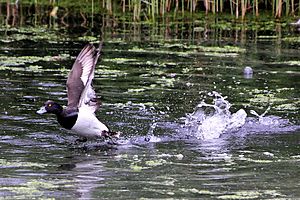Rye Meads facts for kids
| Site of Special Scientific Interest | |

Tufted duck in Rye Meads RSPB reserve
|
|
| Area of Search | Hertfordshire |
|---|---|
| Interest | Biological |
| Area | 58.5 hectares |
| Notification | 1989 |
| Location map | Magic Map |
Rye Meads is a really special place for nature in Hertfordshire, near Rye House. It's a large area, about 58.5 hectares, which is like 145 football fields! This site is officially known as a Site of Special Scientific Interest (SSSI) because of its amazing wildlife.
Rye Meads is part of a chain of wetlands and water areas along the River Lea, just northeast of London. These wetlands are super important. They are even part of a bigger international group of wetlands called a Ramsar site. This means they are recognized worldwide for their importance to nature. It's also a Special Protection Area, which helps protect the birds that live there.
Contents
What Makes Rye Meads Special?
Rye Meads is divided into three main parts. The most well-known part is the Rye Meads nature reserve, which is open for everyone to visit. This reserve is split into two halves, each managed by a different group.
Who Looks After Rye Meads?
- The western part of the nature reserve, right next to the River Lea, is looked after by the Royal Society for the Protection of Birds (RSPB). The RSPB is a charity that works to protect birds and their homes.
- The eastern part of the reserve is managed by the Hertfordshire and Middlesex Wildlife Trust (HMWT). This group helps protect local wildlife and wild places.
- There's also another area south of Rye Road. This part includes meadows and lagoons owned by Thames Water. This section is not open to the public.
Exploring the RSPB Reserve
The RSPB part of Rye Meads is a fantastic place for birdwatching! It has ten special hides where you can quietly watch birds without disturbing them. There are also trails to walk along and a visitor centre where you can learn more.
Some of the cool birds you might spot here include:
- Kingfishers with their bright blue feathers.
- Snipe, which are masters of camouflage.
- green sandpipers, often seen near the water's edge.
- Shovelers with their unique, large bills.
- gadwall ducks.
- tufted ducks, easily recognized by the tuft on their heads.
Discovering the HMWT Area
The HMWT section of Rye Meads is an old flood meadow. This means it's a natural grassland that sometimes gets covered by river water. It has many different types of habitats, like:
- Reedbeds: Tall grasses where many birds and insects live.
- Marshy grassland: Wet grassy areas.
- Fen: Another type of wetland with special plants.
To help keep these habitats healthy, ponies and even water buffalo graze here! They act like natural lawnmowers, keeping the plants at the right height.
Visiting Rye Meads
You can find the entrance to the nature reserve on Rye Road. There's a path that goes all around the site, so you can explore both the RSPB and HMWT areas. Just a heads-up: there's a one-way gate that lets you go from the RSPB side to the HMWT side, but not the other way around. This gate might also be a bit tricky for wheelchairs or pushchairs.
Images for kids


